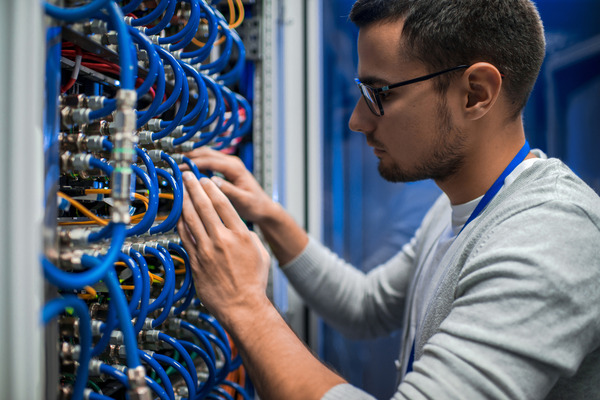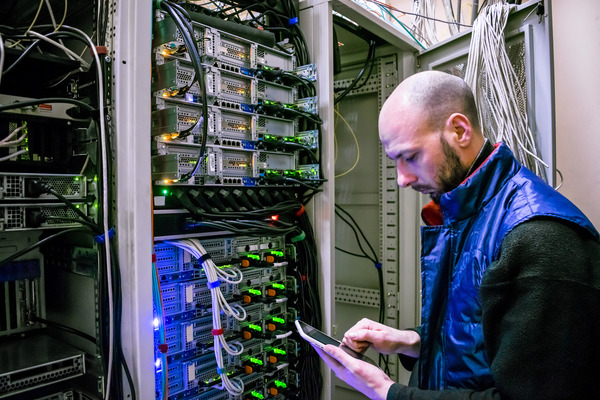
Commercial Data Cabling in Adelaide
What is Data Cabling, and When do I Need it?
You might need to consider having new data cabling installed for your home or office if you are facing any of these problems:
- Slow, laggy, or unreliable internet
- Trying to add new devices to your existing infrastructure
- Renovating your home or office
- Expanding to a new structure that will need a new connection to the same network

The digital revolution may be high-speed, but the infrastructure is slow. Even relatively new buildings constructed with the best intentions can find that demand for data outstrips their cabling supply. People in those buildings immediately start to grumble that ‘the Wi-Fi around here is terrible’ and that they can’t get anything done.
Quietly, behind the scenes, the average number of devices we have been trying to connect to the web has been growing. Consider not only phones and computers but security systems, fire alarms, printers, TVs, and smart devices (like fridges, watches, and washing machines). These gadgets also use data more intensively when you add streaming services, online gaming, and virtual meetings, as well as more frequent updates.
For an ordinary home, the number of devices has increased to ten per household, with younger people using much more data than older people. Covid accelerated this trend by expanding people’s home offices so that more family members could work remotely at jobs or school. Some businesses shifted head-office to their shed on a more permanent basis and discovered that it allowed them to see their family more. Many see it as an unexpected upside that there are more people in neighbourhoods during the day.
Meanwhile, schools and universities, medical facilities, government departments, and businesses kept their ‘doors’ open by delivering services digitally. They needed to expand their data capabilities rapidly, and people got used to it. It now seems more convenient than disruptive for some of those services to be available online. Nobody has a crystal ball, but if you imagine how much cabling you have now, it’s a safe bet that you will need more in the future.
You may be wondering whether it would be cheaper and more convenient to add more wireless capacity than to have cable installed. It may help to know that wired data is faster than wireless by up to 20 times. Cable is also more reliable because it is not disrupted by ordinary things that are part of your house, like walls, power cables, light fittings, and modern foil insulation, or by nearby computers and Wi-Fi networks. Because of all this, cabling handles the distance from the router to the device much better than Wi-Fi. It is a good idea to use cabling wherever you can and save Wi-Fi for those devices (like iPads and phones) that can’t use cable.
Who might need data cabling?
Domestic Houses
A common trigger point for needing more data cabling is when you build an extension to your home, especially if it is freestanding, like a Granny Flat or Studio in the backyard. Some other reasons to have more data cables installed are enclosing the back veranda to use as an expanded home office, or upgrading the shed so that your 3D printer can connect, or just getting your playlist working properly.
Students transitioning to high school can be reason enough to upgrade data facilities. Schools expect them to have a laptop each and use it for homework. Also, teenagers tend to get on each other’s nerves less if they are evenly spaced around the house rather than clustered together near a router. Cabling to a Wi-Fi point near the bedrooms or a rumpus room can make evenings flow a lot more smoothly.

Larger Businesses
Schools, Hospitals, Data Centres, multiple dwellings, and office buildings face even greater pressures to remain up-to-date and efficient because so many more people use them. User expectations are high, and the complexity of the data systems in larger buildings means that more things can go wrong. Obvious trigger points for upgrading cabling will be when building a new (greenfield) structure, renovating an existing structure, or just upgrading the IT systems to accommodate more users (e.g., an influx of Year 7s to a high school) or different technologies (adding smart boards to conference rooms).
When should I talk to someone about data cabling?
Early. Talk is cheap, but some things that can be expensive are:
- Having to re-do cabling because it was put in the wrong place.
- Having to put cabling in an inferior location because it was not put in early enough.
- Having to drill into existing walls when cabling could have been done before the gyprock went on.
- Having to re-route and inconvenience the people trying to use a building when the cabling could have been done before they moved in.
When upgrading cabling in existing structures, these problems are acceptable, and we find ways to complete work with a minimum of fuss. However, completing cabling at an earlier stage, when the walls are off and before the paving goes in is so much faster and less disruptive – it seems a shame to miss the opportunity. So, if you are planning a build, make the call early in the planning stages to get advice on when to schedule a consultation.

Learn more about the Data Cabling Services from CMA Electrical here.
Who can install data cabling?
DIY?
You can do it yourself if the installation or repair is not permanent. So, if it involves plugging in a Wi-Fi hub and clicking some blue LAN cable into the router at one end and the Hub at the other, maybe tacking the cable to the wall with some of those little white plastic clips – go for it.
You need a qualified Telecommunications Cabler.
If the cable needs to go through a wall, that will make it permanent, and the Australian Communications and Media Authority (the regulator) will insist that it only be done by a technician with a valid Telecommunications Cabler qualification. An ordinary electrician’s license is not enough to make the cabling legal, and you should definitely not do it yourself.
We are dedicated to keeping our technicians up to date in their training and certification to use the latest methods, tools, and testing equipment. Legalities aside, this is necessary for the kind of complex jobs we do. For example, in a K-12 school with several campuses, there is likely to be some combination of servers, networks, phones, VoIP, and data storage to integrate so that they are placed correctly and do not interfere with each other. Our team can handle the coordination and project management of multiple sites simultaneously for extended periods, including:
- Initial site audit
- Design and specification of the optic fibre backbone so that the network requirements are met by the physical infrastructure – we have network engineering staff on the team for this purpose.
- Installation of Wireless LAN, testing equipment, optical distribution frames and patch panels etc.
- Final testing
- Manufacturer warranties and full documentation of the project
In short, having inadequate data cabling is likely to be deeply aggravating these days. You certainly want to plan for cabling early when considering a new build or extension. However, increased usage, improvements in technology, and the passage of time will eventually bring that moment to you anyway. When that day comes, put your trust in a well-respected, long-established Adelaide family business with a passion for professional service and know that no matter how complex, we will do the job right.
Learn more about the Data Cabling Services from CMA Electrical here.


